Preparation, Characterization and Tailoring Properties of Poly(Vinyl Chloride) Composites with the Addition of Functional Halloysite–Lignin Hybrid Materials
Abstract
1. Introduction
2. Materials and Methods
2.1. Materials
2.2. Preparation of Halloysite–Lignin Materials
2.3. Characteristics of Halloysite–Lignin Materials
2.4. Preparation of PVC/Halloysite–Lignin Polymer Composites
2.5. Characteristics of PVC/Halloysite–Lignin Composites
2.5.1. Processing Properties
2.5.2. Thermal Properties
2.5.3. Mechanical Properties
2.5.4. Microscope Observations
3. Results and Discussion
3.1. Characteristics of Halloysite–Lignin Materials
3.1.1. Particle Size Distribution and Microscope Observations
3.1.2. FTIR Spectroscopy
3.1.3. TGA Analysis
3.1.4. Zeta Potential Analysis
3.2. Characteristics of PVC/Halloysite–Lignin Composites
3.2.1. Processing Properties
3.2.2. Thermal Properties
3.2.3. Mechanical Properties
3.2.4. Microscope Observations
4. Conclusions
Author Contributions
Funding
Institutional Review Board Statement
Informed Consent Statement
Data Availability Statement
Conflicts of Interest
References
- PVC Market Size, Share, Trends and Growth Analysis Report–Segmented By Application (Construction, Consumer, Packaging, Electrical and Electronics and Transportation) and Region–Industry Forecast|2022 to 2027. Available online: https://www.marketdataforecast.com/market-reports/polyvinyl-chloride-market (accessed on 26 September 2022).
- Polyvinyl chloride (PVC)–Plastics Europe. Available online: https://plasticseurope.org/plastics-explained/a-large-family/polyvinyl-chloride-pvc/ (accessed on 26 September 2022).
- Braun, D. PVC–Origin, growth, and future. J. Vinyl. Addit. Technol. 2001, 7, 168–176. [Google Scholar] [CrossRef]
- Wilkes, C.E.; Summers, J.W.; Daniels, C.A. PVC Handbook; Carl Hanser Verlag GmbH & Co. KG: Munich, Germany, 2005. [Google Scholar]
- Wirawan, R.; Zainudin, E.S.; Sapuan, S.M. Mechanical properties of natural fibre reinforced PVC composites: A review. Sains. Malays. 2009, 38, 531–535. [Google Scholar]
- Mahdi, E.; Dean, A. The Effect of Filler Content on the Tensile Behavior of Polypropylene/Cotton Fiber and Poly(Vinyl Chloride)/Cotton Fiber Composites. Materials 2020, 13, 753. [Google Scholar] [CrossRef]
- Ruxanda, B.; Teaca, C.R.; Spiridon, I. Preparation and characterization of composites comprising modified hardwood and wood polymers/poly(vinyl chloride). BioResources 2009, 4, 1285–1304. [Google Scholar]
- Ranjan, N. Chitosan with PVC polymer for biomedical applications: A bibliometric analysis. Mater. Today Proc. 2022; in press. [Google Scholar] [CrossRef]
- Marceneiro, S.; Lobo, I.; Dias, I.; de Pinho, E.; Dias, A.M.A.; de Sousa, H.C. Eco-friendlier and sustainable natural-based additives for poly(vinyl chloride)-based composites. J. Ind. Eng. Chem. 2022, 110, 248–261. [Google Scholar] [CrossRef]
- Mohd Nurazzi, N.; Khalina, A.; Sapuan, S.M.; Dayang Laila, A.H.A.M.; Rahmah, M.; Hanafee, Z. A review: Fibres, polymer matrices and composites. Pertanika J. Sci. Technol. 2017, 25, 1085–1102. [Google Scholar]
- Abdul Khalil, H.P.S.; Tehrani, M.A.; Davoudpour, Y.; Bhat, A.H.; Jawaid, M.; Hassan, A. Natural fiber reinforced poly(vinyl chloride) composites: A review. J. Reinf. Plast. Compos. 2012, 32, 5. [Google Scholar]
- Iulianelli, G.C.V.; Maciel, P.M.C.; Tavares, M.I.B. Preparation and characterization of PVC/natural filler composites. Macromol. Symp. 2011, 299–300, 227–233. [Google Scholar] [CrossRef]
- Xu, Y.; Wu, Q.; Lei, Y.; Yao, F.; Zhang, Q. Natural fiber reinforced poly(vinyl chloride) composites: Effect of fiber type and impact modifier. J. Polym. Environ. 2008, 16, 250–257. [Google Scholar] [CrossRef]
- Zong, G.; Hao, X.; Hao, J.; Tang, W.; Fang, Y.; Ou, R.; Wang, Q. High-Strength, lightweight, co-extruded wood flour-polyvinyl chloride/lumber composites: Effects of wood content in shell layer on mechanical properties, creep resistance, and dimensional stability. J. Clean. Prod. 2020, 244, 118860. [Google Scholar] [CrossRef]
- Qi, R.; He, C.; Jin, Q. Accelerated weathering of polyvinyl chloride-based wood-plastic composites: Effect of plant species. BioResources 2021, 16, 5261–5271. [Google Scholar] [CrossRef]
- Petchwattana, N.; Covavisaruch, S.; Sanetuntikul, J. Recycling of wood-plastic composites prepared from poly(vinyl chloride) and wood flour. Constr. Build. Mater. 2012, 28, 557–560. [Google Scholar] [CrossRef]
- Chen, J.; Zou, Y.; Ge, H.; Cui, Z.; Liu, S. Mechanical and water absorption behaviors of corn stalk/sisal fiber-reinforced hybrid composites. J. Appl. Polym. Sci. 2018, 135, 46405. [Google Scholar] [CrossRef]
- Nedjma, S.; Djidjelli, H.; Boukerrou, A.; Grohens, Y.; Chibani, N.; Benachour, D.; Pillin, I. Effect of chemical treatment on newspaper fibers reinforced polymer poly(vinyl chloride) composites. J. Vinyl. Addit. Technol. 2016, 22, 173–181. [Google Scholar] [CrossRef]
- Saini, G.; Choudhary, V.; Bhardwaj, R.; Narula, A.K. Study on PVC composites containing Eugenia jambolana wood flour. J. Appl. Polym. Sci. 2008, 107, 2171–2179. [Google Scholar] [CrossRef]
- Rocha, N.; Kazlauciunas, A.; Gil, M.H.; Gonçalves, P.M.; Guthrie, J.T. Poly(vinyl chloride)–wood flour press mould composites: The influence of raw materials on performance properties. Compos. Part A Appl. Sci. Manuf. 2009, 40, 653–661. [Google Scholar] [CrossRef]
- Mirowski, J.; Oliwa, R.; Oleksy, M.; Rój, E.; Tomaszewska, J.; Mizera, K.; Ryszkowska, J. Composites of poly(vinyl chloride) with residual hops after supercritical extraction in CO2. Polymers 2021, 13, 2736. [Google Scholar] [CrossRef]
- Mirowski, J.; Oliwa, R.; Oleksy, M.; Tomaszewska, J.; Ryszkowska, J.; Budzik, G. Poly(Vinyl chloride) composites with raspberry pomace filler. Polymers 2021, 13, 1079. [Google Scholar] [CrossRef]
- Thakur, V.K.; Thakur, M.K.; Raghavan, P.; Kessler, M.R. Progress in Green Polymer Composites from Lignin for Multifunctional Applications: A Review. ACS Sustain. Chem. Eng. 2014, 2, 1072–1092. [Google Scholar] [CrossRef]
- Ridho, M.R.; Agustiany, E.A.; Rahmi, D.M.; Madyaratri, E.W.; Ghozali, M.; Restu, W.K.; Falah, F.; Rahandi Lubis, M.A.; Syamani, F.A.; Nurhamiyah, Y.; et al. Lignin as green filler in polymer composites: Development methods, characteristics, and potential applications. Adv. Mater. Sci. Eng. 2022, 2022, 1363481. [Google Scholar] [CrossRef]
- Feldman, D.; Banu, D. Interactions in poly(vinyl chloride)–lignin blends. J. Adhes. Sci. Technol. 2003, 17, 2065–2083. [Google Scholar] [CrossRef]
- Liu, F.; Xu, K.; Chen, M.; Cao, D. The rheological and mechanical properties of PVC-lignin blends. Int. Polym. Process. 2012, 27, 121–127. [Google Scholar] [CrossRef]
- Yong, M.; Zhang, Y.; Sun, S.; Liu, W. Properties of polyvinyl chloride (PVC) ultrafiltration membrane improved by lignin: Hydrophilicity and antifouling. J. Membr. Sci. 2019, 575, 50–59. [Google Scholar] [CrossRef]
- Taib, M.N.A.M.; Antov, P.; Savov, V.; Fatriasari, W.; Madyaratri, E.W.; Wirawan, R.; Makovická Osvaldová, L.; Huag, L.S.; Ghani, M.A.A.; Al Edrus, S.S.A.O.; et al. Current progress of biopolymer-based flame retardant. Polym. Degrad. Stabil. 2022, 205, 110153. [Google Scholar] [CrossRef]
- Solihat, N.N.; Hidayat, A.F.; Taib, M.N.A.M.; Hussin, M.H.; Lee, S.H.; Ghani, M.A.A.; Al Edrus, S.S.A.O.; Vahabi, H.; Fatriasari, W. Recent Developments in Flame-Retardant Lignin-Based Biocomposite: Manufacturing, and characterization. J. Polym. Environ. 2022, 30, 4517–4537. [Google Scholar] [CrossRef]
- Agustiany, E.A.; Ridho, M.R.; Muslimatul Rahmi, D.N.; Madyaratri, E.W.; Falah, F.; Lubis, M.A.R.; Solihat, N.N.; Syamani, F.A.; Karungamye, P.; Sohail, A.; et al. Recent developments in lignin modification and its application in lignin-based green composites: A review. Polym. Compos. 2022, 43, 4848–4865. [Google Scholar] [CrossRef]
- Solihat, N.N.; Sari, F.P.; Falah, F.; Ismayati, M.; Lubis, M.A.R.; Fatriasari, W.; Santoso, E.B.; Syafii, W. Lignin as an Active Biomaterial: A Review. Jurnal Sylva Lestari 2021, 9, 1–22. [Google Scholar] [CrossRef]
- Jędrzejczak, P.; Puszka, A.; Kubiak, A.; Podkościelna, B.; Klapiszewski, Ł. New lignin-based hybrid materials as functional additives for polymer biocomposites: From design to application. Int. J. Biol. Macromol. 2021, 190, 624–635. [Google Scholar] [CrossRef]
- Klapiszewski, Ł.; Grząbka-Zasadzińska, A.; Borysiak, S.; Jesionowski, T. Preparation and characterization of polypropylene composites reinforced by functional ZnO/lignin hybrid materials. Polym. Test. 2019, 79, 106058. [Google Scholar] [CrossRef]
- Klapiszewski, Ł.; Bula, K.; Dobrowolska, A.; Czaczyk, K.; Jesionowski, T. A high-density polyethylene container based on ZnO/lignin dual fillers with potential antimicrobial activity. Polym. Test. 2019, 73, 51–59. [Google Scholar] [CrossRef]
- Grząbka-Zasadzińska, A.; Klapiszewski, Ł.; Borysiak, S.; Jesionowski, T. Thermal and mechanical properties of silica–lignin/polylactide composites subjected to biodegradation. Materials 2018, 11, 2257. [Google Scholar] [CrossRef] [PubMed]
- Bula, K.; Klapiszewski, Ł.; Jesionowski, T. A novel functional silica/lignin hybrid material as a potential bio-based polypropylene filler. Polym. Compos. 2015, 36, 913–922. [Google Scholar] [CrossRef]
- Dahmardeh Ghalehno, M.; Kord, B.; Adlnasab, L. Evaluation of thermal degradation behavior and fire resistance performance of wood-plastic composites containing different modified clay nanoparticles. Wood Mater. Sci. Eng. 2022; in press. [Google Scholar] [CrossRef]
- Cui, X.; Liu, L.; Liu, X.; Li, Y.; He, Z.; Liu, L.; Zhang, M.; Zhu, Y.; Wang, X. PVC Coated Lignin/silica composites derived from biomass rice husks as a high performance anode material for lithium ion batteries. Chem. Select 2022, 7, e202201209. [Google Scholar] [CrossRef]
- Zhang, W.; Wu, H.; Zhou, N.; Cai, X.; Zhang, Y.; Hu, H.; Feng, Z.; Huang, Z.; Liang, J. Enhanced thermal stability and flame retardancy of poly(vinyl chloride) based composites by magnesium borate hydrate-mechanically activated lignin. J. Inorg. Organomet. Polym. Mater. 2021, 31, 3842–3856. [Google Scholar] [CrossRef]
- Kiani, H.; Ashori, A.; Mozaffari, S.A. Water resistance and thermal stability of hybrid lignocellulosic filler-PVC composites. Polym. Bull. 2011, 66, 797–802. [Google Scholar] [CrossRef]
- Klapiszewski, Ł.; Pawlak, F.; Tomaszewska, J.; Jesionowski, T. Preparation and characterization of novel PVC/silica-lignin composites. Polymers 2015, 7, 1767–1788. [Google Scholar] [CrossRef]
- Tomaszewska, J.; Klapiszewski, Ł.; Skórczewska, K.; Szalaty, T.J.; Jesionowski, T. Advanced organic-inorganic hybrid fillers as functional additives for poly(vinyl chloride). Polimery 2017, 62, 19–26. [Google Scholar] [CrossRef]
- Klapiszewski, Ł.; Tomaszewska, J.; Skórczewska, K.; Jesionowski, T. Preparation and characterization of eco-friendly Mg(OH)2/lignin hybrid material and its use as a functional filler for poly(vinyl chloride). Polymers 2017, 9, 258. [Google Scholar] [CrossRef]
- Deng, S.; Zhang, J.; Ye, L.; Wu, J. Toughening epoxies with halloysite nanotubes. Polymer 2008, 49, 5119–5127. [Google Scholar] [CrossRef]
- Mondragón, M.; Roblero-Linares, Y.S.; Sánchez-Espíndola, M.E.; Zendejas-Leal, B.E. Rigid Poly(vinyl chloride)/Halloysite Nanocomposites. NSTI-Nanotech 2009, 2, 482–484. [Google Scholar]
- Pasbakhsh, P.; Ismail, H.M.N.; Fauzi, A.; Abu Bakar, A. Halloysite nanotubes as a novel nanofiller for polymer nanocomposites. In Proceedings of the Extended Abstracts–21st Australian Clay Minerals Conference, Brisbane, Australia, 18–21 August 2010; pp. 93–96. [Google Scholar]
- Liu, C.; Luo, Y.; Jia, Z.; Li, S.; Guo, B.; Jia, D. Structure and properties of poly(vinyl chloride)/halloysite nanotubes nanocomposites. J. Macromol. Sci. Part B Phys. 2012, 51, 968–981. [Google Scholar] [CrossRef]
- Liu, C.; Luo, Y.; Jia, Z.; Li, S.; Huang, D.; Jia, D. Particle Configuration and properties of poly(vinyl chloride)/halloysite nanotubes nanocomposites via in situ suspension polymerization. Polym. Compos. 2014, 35, 856–863. [Google Scholar] [CrossRef]
- Liu, C.; Luo, Y.; Jia, Z.; Zhong, B.C.; Li, S.; Guo, B.; Jia, D. Thermal Degradation Behaviors of Poly(vinyl chloride)/Halloysite Nanotubes Nanocomposites. Int. J. Polym. Mater. Polym. Biomater. 2013, 62, 128–132. [Google Scholar] [CrossRef]
- Liu, M.; Jia, Z.; Jia, D.; Zhoua, C. Recent advance in research on halloysite nanotubes-polymer nanocomposite. Prog. Polym. Sci. 2014, 39, 1498–1525. [Google Scholar] [CrossRef]
- Liu, M.; Zhang, Y.; Zhou, C. Nanocomposites of halloysite and polylactide. Appl. Clay Sci. 2013, 75–76, 52–59. [Google Scholar] [CrossRef]
- Nakamura, R.; Netravali, A.N.; Morgan, A.B.; Nyden, M.R.; Gilman, J.W. Effect of halloysite nanotubes on mechanical properties and flammability of soy protein based green composites. FIRE Mater. 2012, 37, 75–90. [Google Scholar] [CrossRef]
- Silva, R.T.; Soheilmoghaddam, M.; Goh, K.L.; Wahit, M.U.; Hamid, S.B.A.; Chai, S.-P.; Pasbakhsh, P. Influence of the Processing Methods on the Properties of Poly(lactic acid)/Halloysite Nanocomposites. Polym. Compos. 2016, 37, 861–869. [Google Scholar] [CrossRef]
- Gaaz, T.S.; Sulong, A.B.; Kadhum, A.A.H.; Al-Amiery, A.A.; Nassir, M.H.; Jaaz, A.H. The Impact of Halloysite on the Thermo-Mechanical Properties of Polymer Composites. Molecules 2017, 22, 838. [Google Scholar] [CrossRef]
- Buruga, K.; Kalathi, J.T.; Kim, K.H.; Ok, Y.S.; Danil, B. Polystyrene-halloysite nano tube membranes for water purification. J. Ind. Eng. Chem. 2018, 61, 169–180. [Google Scholar] [CrossRef]
- Yang, X.; Zhang, Y.; Zheng, D.; Yue, J.; Liu, M. Nano-biocomposite films fabricated from cellulose fibers and halloysite nanotubes. Appl. Clay Sci. 2020, 190, 105565. [Google Scholar] [CrossRef]
- Jouyandeh, M.; Tikhani, F.; Hampp, N.; Akbarzadeh Yazdi, D.; Zarrintaj, P.; Ganjali, M.R.; Saeb, M.R. Highly curable self-healing vitrimer-like cellulose-modified halloysite nanotube/epoxy nanocomposite coatings. Chem. Eng. J. 2020, 396, 125196. [Google Scholar] [CrossRef]
- Nikafshar, S.; Mccracken, J.; Dunne, K.; Nejad, M. Improving UV-stability of epoxy coating using encapsulated halloysite nanotubes with organic UV-stabilizers and lignin. Prog. Org. Coat. 2021, 158, 106338. [Google Scholar] [CrossRef]
- Alhuthali, A.M.; Low, I.M. Influence of halloysite nanotubes on physical and mechanical properties of cellulose fibres reinforced vinyl-ester composites. J. Reinf. Plast. Compos. 2013, 32, 233–247. [Google Scholar] [CrossRef]
- Li, M.; Shan, J.; Hu, Y.; Gao, C.; Long, H.; Shen, T.; Tan, Z.; Zhuang, W.; Liu, D.; Zhu, C.; et al. Lignin demethylation for modifying halloysite nanotubes towards robust phenolic foams with excellent thermal insulation and flame retardancy. J. Appl. Polym. Sci. 2022, 139, 52019. [Google Scholar] [CrossRef]
- Krishnaiah, P.; Manickam, S.; Ratnam, C.T.; Raghu, M.S.; Parashuram, L.; Prashantha, K.; Jeon, B.-H. Surface-treated short sisal fibers and halloysite nanotubes for synergistically enhanced performance of polypropylene hybrid composites. J. Thermoplast. Compos. Mater. 2020, 2020, 0892705720946063. [Google Scholar] [CrossRef]
- ISO 182-1:1990; Plastics–Determination of the Tendency of Compounds and Products Based on Vinyl Chloride Homopolymers and Copolymers to Evolve Hydrogen Chloride and Any Other Acidic Products at Elevated Temperatures–Part 1: Congo Red Method. International Organization for Standardization: Geneva, Switzerland, 1990.
- ISO 306:2006; Plastics-Thermoplastic Materials–Determination of Vicat Softening Temperature (VST). ISO: Geneva, Switzerland, 2006.
- ISO 527-1:2012; Plastics-Determination of Tensile Properties–Part 1: General Principles. International Organization for Standardization: Geneva, Switzerland, 2012.
- ISO 179-2:2010; Plastics-Determination of Charpy Impact Properties–Part 2: Instrumented Impact Test. ISO: Geneva, Switzerland, 2010.
- Hebbar, R.S.; Isloor, A.M.; Ananda, K.; Ismail, A.F. Fabrication of polydopamine functionalized halloysite nanotube/polyetherimide membranes for heavy metal removal. J. Mater. Chem. A 2016, 4, 764–774. [Google Scholar] [CrossRef]
- Pasbakhsh, P.; Ismail, H.; Fauzi, M.N.A.; Bakar, A.A. EPDM/modified halloysite nanocomposites. Appl. Clay Sci. 2010, 48, 405–413. [Google Scholar] [CrossRef]
- Klapiszewski, Ł.; Nowacka, M.; Milczarek, G.; Jesionowski, T. Physicochemical and electrokinetic properties of silica/lignin biocomposites. Carbohydr. Polym. 2013, 94, 345–355. [Google Scholar] [CrossRef]
- Tomaszewska, J.; Sterzyński, T.; Piszczek, K. Rigid poly(vinyl chloride) gelation in a Brabender measuring mixer. III. Transformation in the torque maximum. J. Appl. Polym. Sci. 2007, 106, 3158–3164. [Google Scholar] [CrossRef]
- Ari, G.A.; Aydin, I. A study on fusion and rheological behaviors of PVC/SiO2 microcomposites and nanocomposites: The effects of SiO2 particle size. Polym. Eng. Sci. 2011, 51, 1575–1579. [Google Scholar] [CrossRef]
- Chen, C.-H.; Li, H.-C.; Teng, C.-C.; Yang, C.-H. Fusion, electrical conductivity, thermal, and mechanical properties of rigid poly(vinyl chloride) (PVC)/carbon black (CB) composites. J. Appl. Polym. Sci. 2006, 99, 2167–2173. [Google Scholar] [CrossRef]
- Owen, E.D. Degradation and Stabilisation of PVC, 1st ed.; Elsevier Applied Science Publishers: London, UK; New York, NY, USA, 1984. [Google Scholar]
- Iván, B. The Stability of Poly(Vinyl Chloride). J. Vinyl Addit. Technol. 2003, 9, 1–3. [Google Scholar] [CrossRef]
- Elakesh, E.O.; Hull, T.R.; Price, D.; Carty, P. Thermal decomposition of chlorinated poly(vinyl chloride) (CPVC). J. Vinyl Addit. Technol. 2003, 9, 116–126. [Google Scholar] [CrossRef]
- Tomaszewska, J.; Sterzynski, T.; Walczak, D. Thermal Stability of Nanosilica-Modified Poly(vinyl chloride). Polymers 2021, 13, 2057. [Google Scholar] [CrossRef]
- Zheng, X.-G.; Tang, L.-H.; Zhang, N.; Gao, Q.-H.; Zhang, C.-F.; Zhu, Z.-B. Dehydrochlorination of PVC Materials at High Temperature. Energy Fuels 2003, 17, 896–900. [Google Scholar] [CrossRef]
- Moghri, M.; Niculina Dragoi, E.; Salehabadi, A.; Shukla, D.K.; Vasseghian, Y. Effect of various formulation ingredients on thermal characteristics of PVC/clay nanocomposite foams: Experimental and modeling. e-Polymers 2017, 17, 119–128. [Google Scholar] [CrossRef]
- Zhou, H.; Wu, C.; Onwudili, J.A.; Meng, A.; Zhang, Y.; Williams, P.T. Effect of interactions of PVC and biomass components on the formation of polycyclicaromatic hydrocarbons (PAH) during fast co-pyrolysis. RSC Adv. 2015, 5, 11371–11377. [Google Scholar] [CrossRef]
- Czegeny, Z.; Jakab, E.; Bozi, J.; Blazso, M. Pyrolysis of wood–PVC mixtures. Formation of chloromethane from lignocellulosic materials in the presence of PVC. J. Anal. Appl. Pyrol. 2015, 113, 123–132. [Google Scholar] [CrossRef]
- Zhao, X.; Zhang, Y.; Hu, H.; Huang, Z.; Qin, Y.; Shen, F.; Huang, A.; Feng, Z. Effect of lignin esters on improving the thermal properties of poly(vinyl chloride). J. Appl. Polym. Sci. 2019, 136, 47176. [Google Scholar] [CrossRef]
- Wieczorek, M.; Tomaszewska, J.; Bajda, T.; Długosz, J. Effect of calcinated halloysite on structure and properties of rigid poly(vinyl chloride) composites. Chem. Process Eng. 2022, in press. [Google Scholar]
- Ponce, G.; Rodríguez-Llamazares, S.; Castaño Rivera, P.; Castaño, J. Biocomoposites of polylactic acid/ poly(butylene adipate co terephthalate) blends loaded with quinoa husk agro waste: Thermal and mechanical properties. J. Polym. Res. 2022, 29, 356. [Google Scholar] [CrossRef]
- Chuayjuljit, S.; Kongthan, J.; Chaiwutthinan, P.; Boonmahitthisud, A. Poly(vinyl chloride)/Poly(butylene succinate)/wood flour composites: Physical properties and biodegradability. Polym. Compos. 2018, 39, 1543–1552. [Google Scholar] [CrossRef]
- Abdellah Ali, S.F.; El Batouti, M.; Abdelhamed, M.; El-Rafey, E. Formulation and characterization of new ternary stable composites: Polyvinyl chloride-wood flour calcium carbonate of promising physicochemical properties. J. Mater. Res. Technol. 2020, 9, 12840–12854. [Google Scholar] [CrossRef]
- Ping, Q.W.; Xiao, J.; Zhao, J. The preparation and property of organic solvent lignin and PVC composite materials. Adv. Mater. Res. 2011, 236–238, 1195–1198. [Google Scholar] [CrossRef]
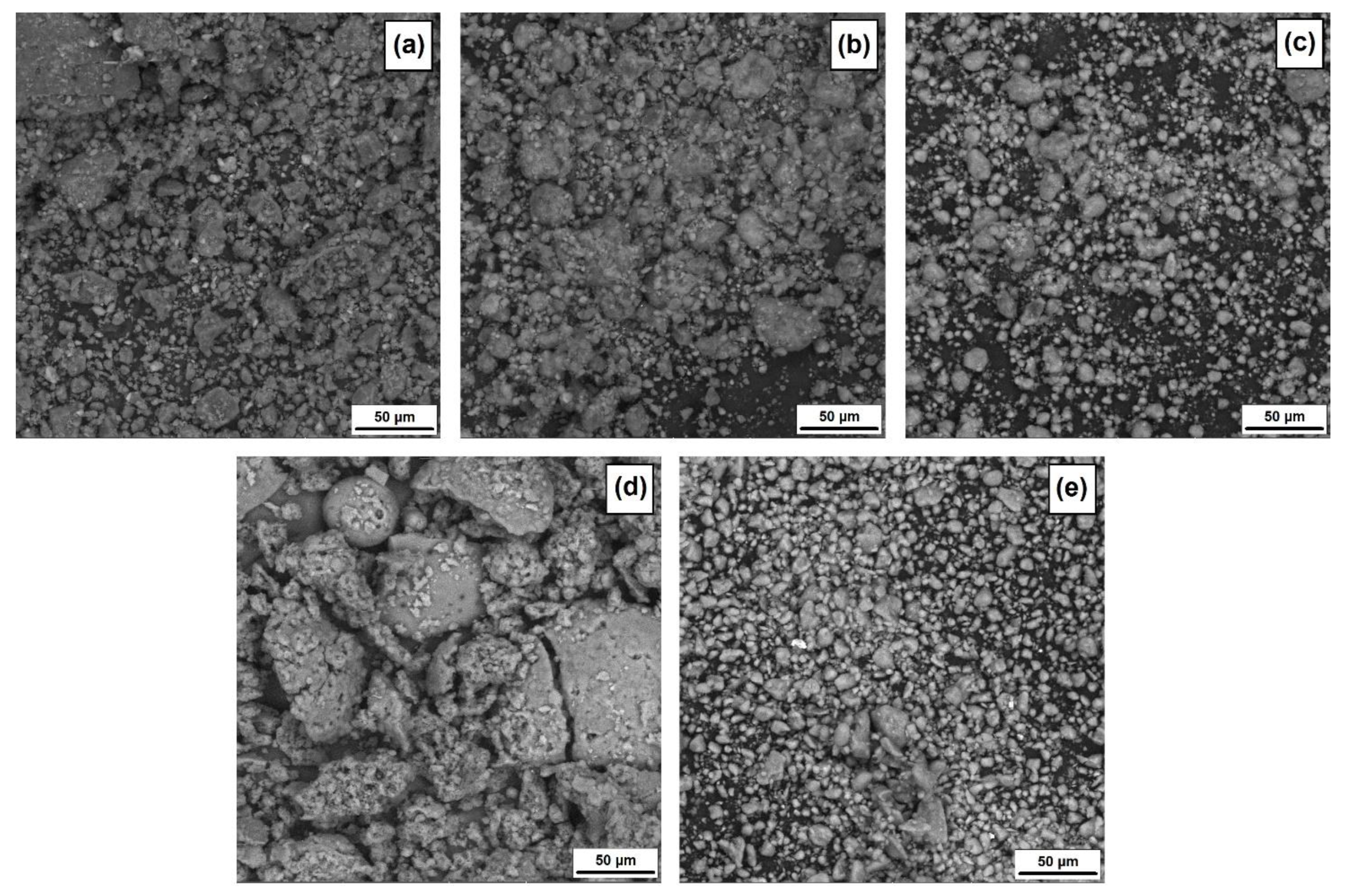
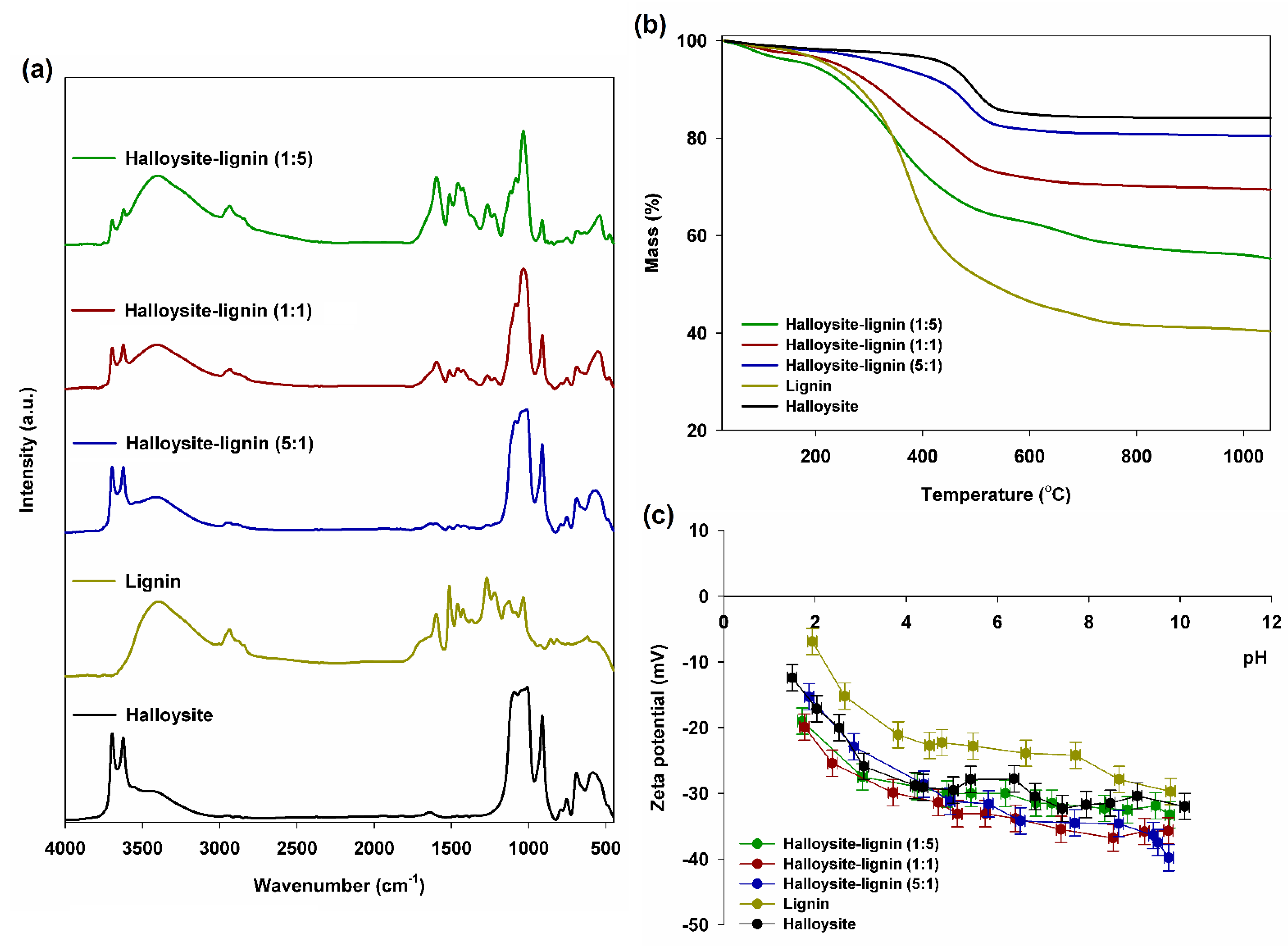


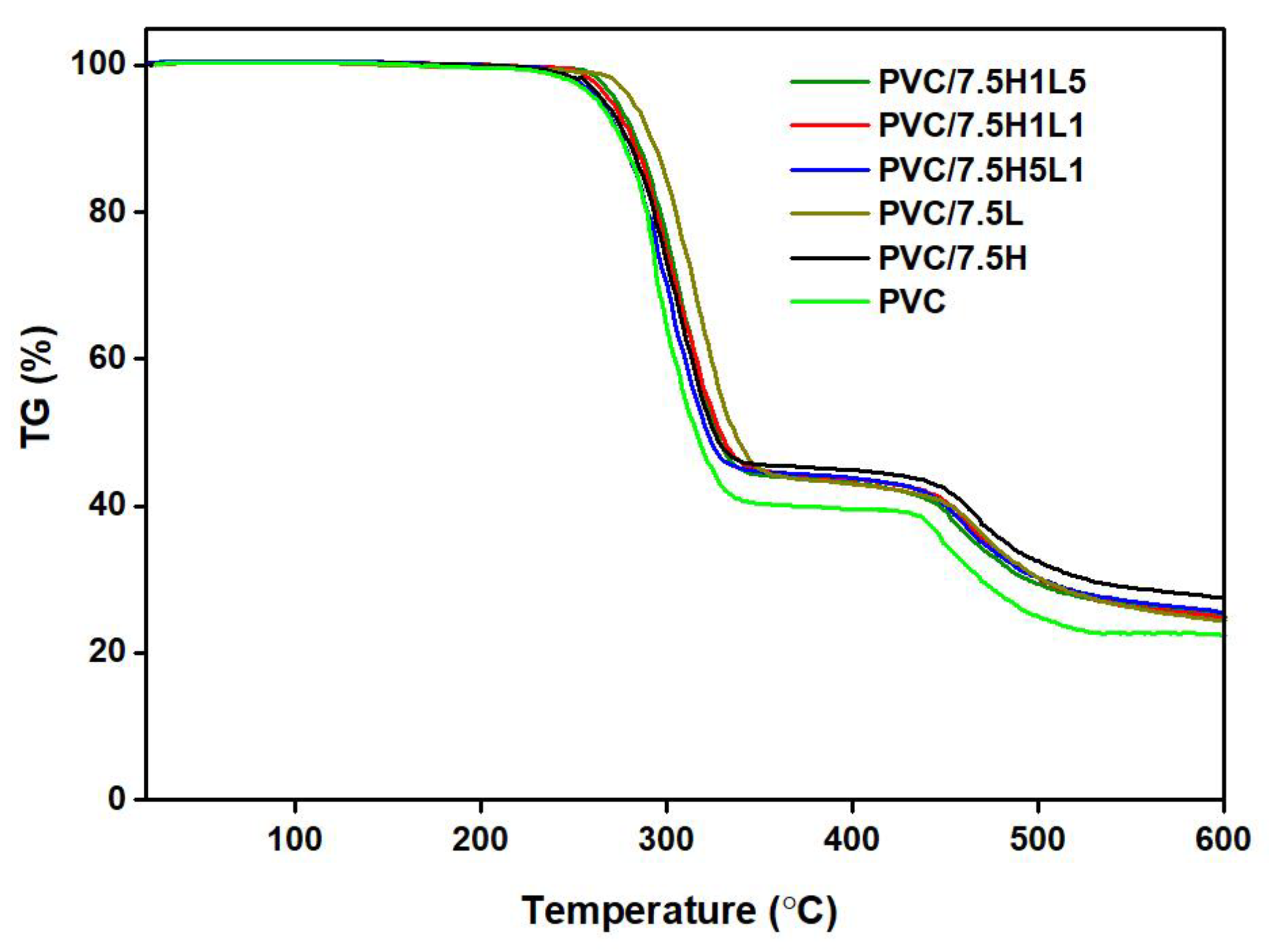
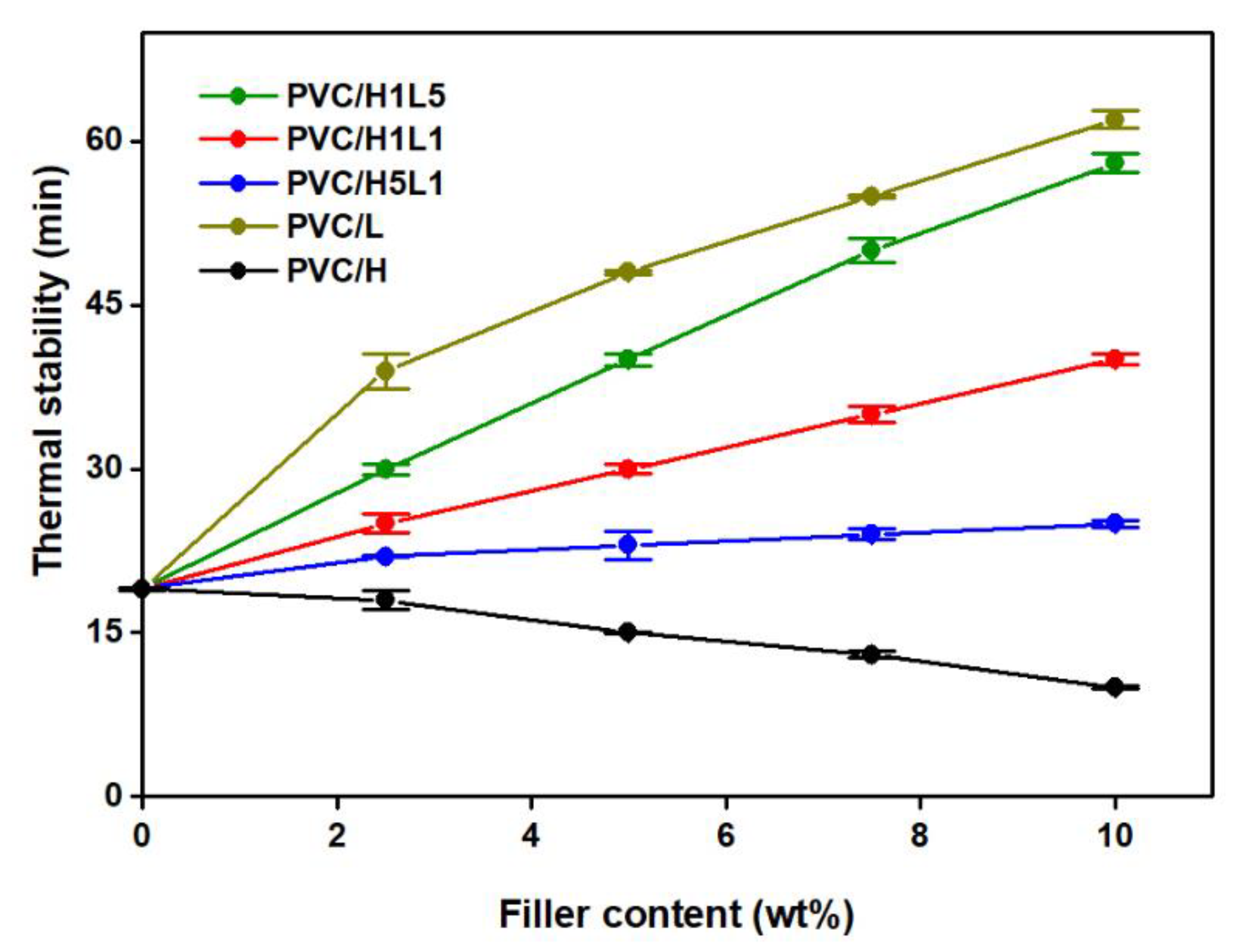
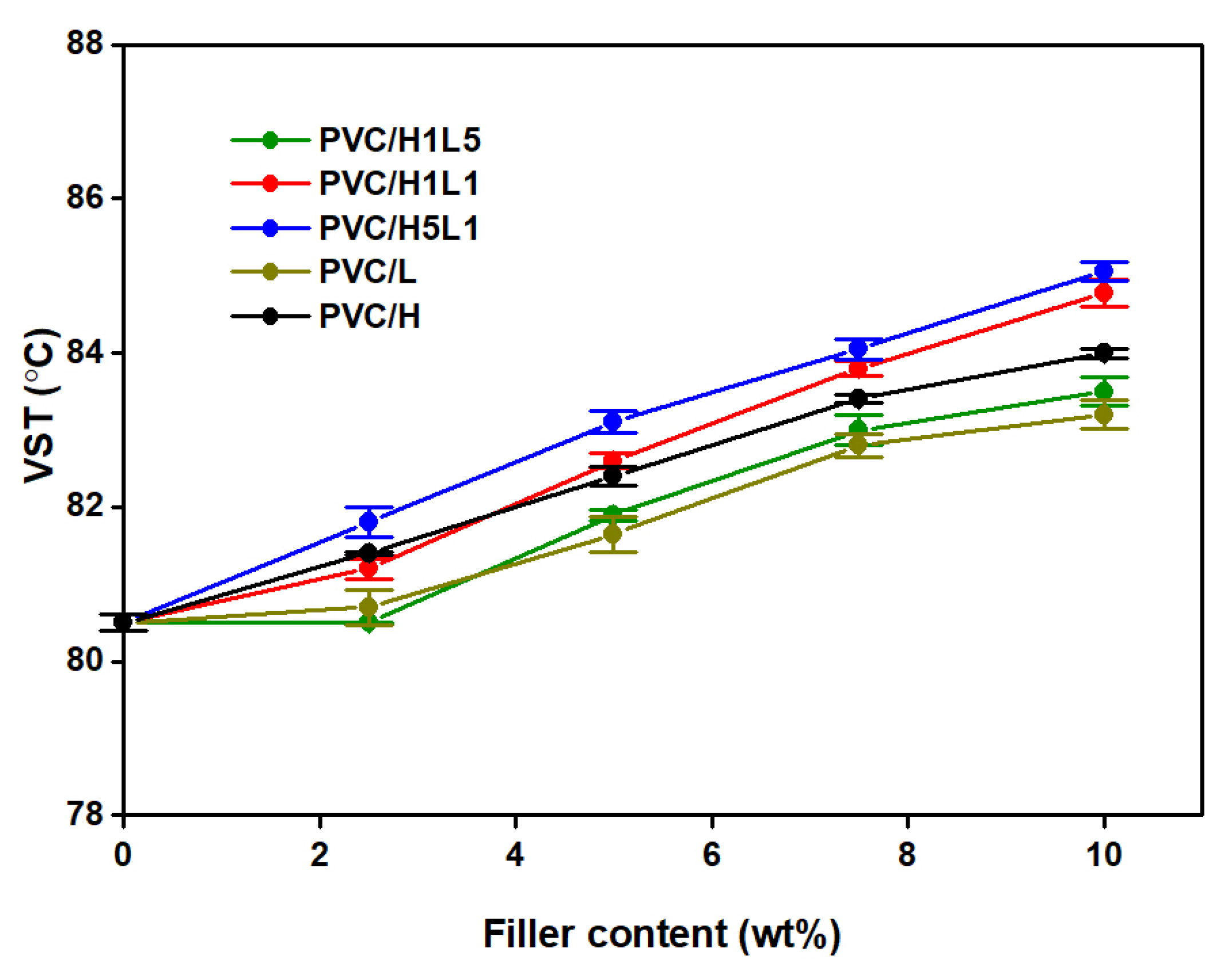

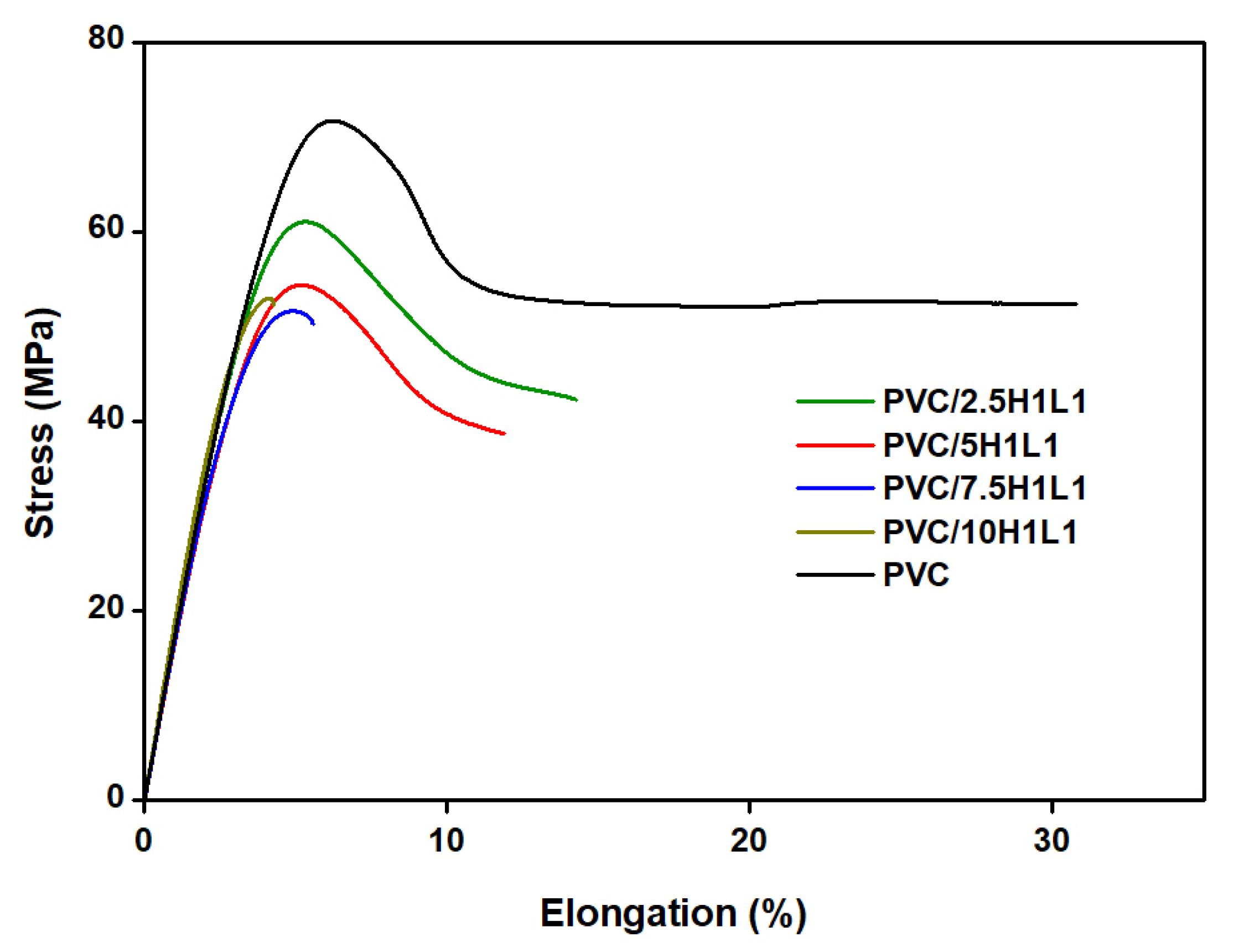

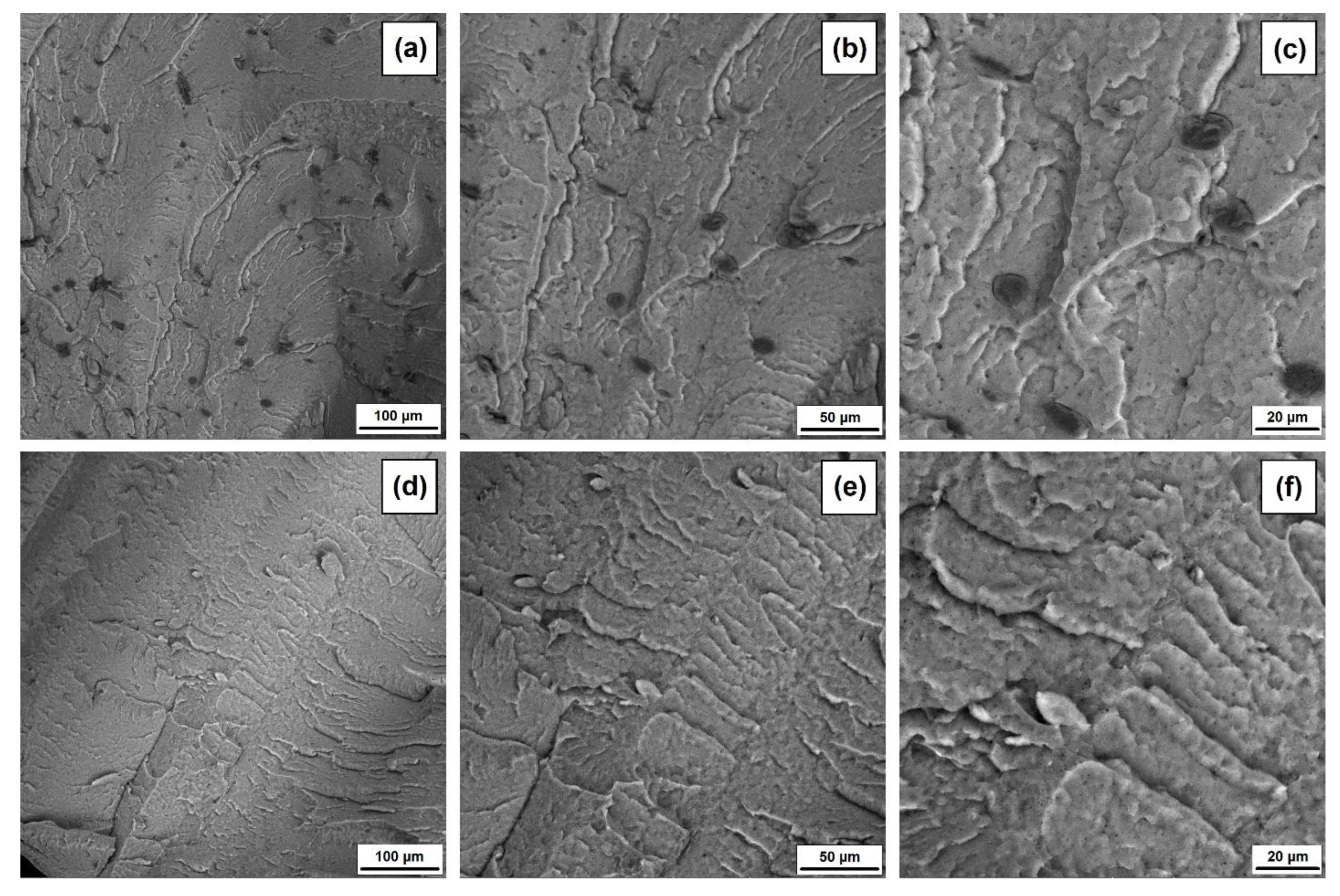
| Sample Name | Filler Type | Filler Content, wt. % |
|---|---|---|
| PVC | ||
| PVC/2.5H | halloysite | 2.5 |
| PVC/5H | 5 | |
| PVC/7.5H | 7.5 | |
| PVC/10H | 10 | |
| PVC/2.5L | lignin | 2.5 |
| PVC/5L | 5 | |
| PVC/7.5L | 7.5 | |
| PVC/10L | 10 | |
| PVC/2.5H1L5 | halloysite–lignin (1:5 wt/wt) | 2.5 |
| PVC/5H1L5 | 5 | |
| PVC/7.5H1L5 | 7.5 | |
| PVC/10H1L5 | 10 | |
| PVC/2.5H1L1 | halloysite–lignin (1:1 wt/wt) | 2.5 |
| PVC/5H1L1 | 5 | |
| PVC/7.5H1L1 | 7.5 | |
| PVC/10H1L1 | 10 | |
| PVC/2.5H5L1 | halloysite–lignin (5:1 wt/wt) | 2.5 |
| PVC/5H5L1 | 5 | |
| PVC/7.5H5L1 | 7.5 | |
| PVC/10H5L1 | 10 |
| Sample | Particle Size Distribution (nm) | Polydispersity Index |
|---|---|---|
| Halloysite–lignin (1:5 wt/wt) | 142–459 | 0.218 |
| Halloysite–lignin (1:1 wt/wt) | 106–615 | 0.377 |
| Halloysite–lignin (5:1 wt/wt) | 91–459; 1281–1990 | 0.452 |
| Lignin | 164–342; 459–6439 | 0.988 |
| Halloysite | 68–396; 1281–3580 | 0.654 |
| Sample Name | Temperature of Weight Loss (°C) | RM at 700 °C (%) | |||
|---|---|---|---|---|---|
| T1% | T5% | T10% | T50% | ||
| PVC | 250.5 | 266.3 | 276.1 | 316.0 | 18.1 |
| PVC/2.5H | 250.1 | 269.3 | 280.5 | 324.5 | 21.3 |
| PVC/5H | 243.7 | 267.7 | 278.9 | 325.3 | 21.5 |
| PVC/7.5H | 240.3 | 266.7 | 278.2 | 325.9 | 24.0 |
| PVC/10H | 238.1 | 266.1 | 278.9 | 325.1 | 26.2 |
| PVC/2.5L | 256.1 | 273.6 | 283.1 | 325.5 | 18.3 |
| PVC/5L | 261.1 | 276.6 | 285.5 | 330.3 | 19.9 |
| PVC/7.5L | 259.7 | 281.3 | 291.6 | 336.3 | 22.1 |
| PVC/10L | 260.1 | 277.3 | 287.1 | 330.3 | 22.9 |
| PVC/2.5H1L5 | 253.9 | 271.1 | 282.2 | 326.4 | 18.7 |
| PVC/5H1L5 | 256.3 | 273.9 | 285.0 | 328.6 | 20.5 |
| PVC/7.5H1L5 | 257.9 | 273.7 | 283.5 | 327.3 | 22.1 |
| PVC/10H1L5 | 252.3 | 274.7 | 284.2 | 330.1 | 22.5 |
| PVC/2.5H1L1 | 251.9 | 269.5 | 280.5 | 324.7 | 20.0 |
| PVC/5H1L1 | 253.5 | 272.3 | 283.0 | 327.2 | 21.1 |
| PVC/7.5H1L1 | 253.1 | 270.7 | 281.3 | 328.8 | 21.7 |
| PVC/10H1L1 | 255.5 | 272.7 | 283.9 | 330.0 | 23.9 |
| PVC/2.5H5L1 | 249.5 | 269.3 | 279.7 | 324.6 | 19.8 |
| PVC/5H5L1 | 243.1 | 263.3 | 276.6 | 321.3 | 20.6 |
| PVC/7.5H5L1 | 242.3 | 264.0 | 275.9 | 322.0 | 22.3 |
| PVC/10H5L1 | 242.3 | 264.7 | 276 | 323.6 | 24.3 |
| Sample Name | E’ (MPa) | Tg (°C) | ||
|---|---|---|---|---|
| 30 °C | 50 °C | 70 °C | ||
| PVC | 3136 | 2979 | 2548 | 94.7 |
| PVC/2.5H | 3263 | 3120 | 2712 | 92.6 |
| PVC/5H | 3698 | 3525 | 3066 | 92.9 |
| PVC/7.5H | 3764 | 3616 | 3189 | 93.7 |
| PVC/10H | 4027 | 3828 | 3234 | 92.7 |
| PVC/2.5L | 3265 | 3063 | 2733 | 93.9 |
| PVC/5L | 3514 | 3341 | 2823 | 94.3 |
| PVC/7.5L | 3582 | 3389 | 2888 | 94.7 |
| PVC/10L | 3565 | 3379 | 2938 | 94.5 |
| PVC/2.5H1L5 | 3191 | 3043 | 2613 | 93.9 |
| PVC/5H1L5 | 3229 | 3056 | 2638 | 94.5 |
| PVC/7.5H1L5 | 3709 | 3523 | 3086 | 96.7 |
| PVC/10H1L5 | 3747 | 3548 | 3056 | 94.4 |
| PVC/2.5H1L1 | 3213 | 3063 | 2676 | 94.0 |
| PVC/5H1L1 | 3249 | 3085 | 2674 | 94.4 |
| PVC/7.5H1L1 | 3702 | 3525 | 3044 | 95.9 |
| PVC/10H1L1 | 3749 | 3546 | 3049 | 95.7 |
| PVC/2.5H5L1 | 3209 | 3054 | 2729 | 94.1 |
| PVC/5H5L1 | 3360 | 3202 | 2763 | 93.7 |
| PVC/7.5H5L1 | 3463 | 3281 | 2749 | 95.7 |
| PVC/10H5L1 | 3795 | 3605 | 3128 | 94.7 |
| Sample | acU (kJ/m2) | Et (MPa) | σY (MPa) | σM (MPa) | ɛB (%) |
|---|---|---|---|---|---|
| PVC | 15.6 ± 1.6 | 1630 ± 15.2 | 65.6 ± 10.8 | 65.6 ± 10.5 | 22.3 ± 12 |
| PVC/2.5H | 30.0 ± 5.7 | 1690 ± 19.5 | 58.6 ± 0.7 | 58.6 ± 0.7 | 174.7 ± 40.1 |
| PVC/5H | 15.6 ± 3.0 | 1740 ± 12.7 | 58.8 ± 0.3 | 58.8 ± 0.3 | 53.3 ± 5.2 |
| PVC/7.5H | 8.2 ± 1.1 | 1800 ± 12.2 | 58.9 ± 0.6 | 58.9 ± 0.5 | 6.9 ± 1.4 |
| PVC/10H | 6.1 ± 1.1 | 1840 ± 13.4 | 57.7 ± 0.5 | 57.7 ± 0.5 | 6.8 ± 1.6 |
| PVC/2.5L | 18.7 ± 0.9 | 1620 ± 10.7 | 56.1 ± 0.4 | 56.1 ± 0.4 | 47.8 ± 31.0 |
| PVC/5L | 17.6 ± 1.0 | 1620 ± 23.3 | 51.2 ± 1.1 | 51.3 ± 1.1 | 8.8 ± 1.0 |
| PVC/7.5L | 16.1 ± 2.3 | 1690 ± 8.9 | 52.8 ± 0.4 | 52.8 ± 0.4 | 16.4 ± 7.1 |
| PVC/10L | 11.6 ± 1.8 | 1730 ± 11.2 | 53.6 ± 0.5 | 53.6 ± 0.5 | 8.1 ± 2.4 |
| PVC/2.5H1L5 | 21.2 ± 3.5 | 1800 ± 26.1 | 60.7 ± 0.8 | 60.7 ± 0.8 | 44.6 ± 31.4 |
| PVC/5H1L5 | 16.8 ± 2.2 | 1830 ± 8.4 | 57.3 ± 0.2 | 57.3 ± 0.2 | 11.0 ± 4.6 |
| PVC/7.5H1L5 | 11.7 ± 1.6 | 1880 ± 23.6 | 56.3 ± 0.7 | 56.3 ± 0.7 | 10.4 ± 1.0 |
| PVC/10H1L5 | 11.0 ± 1.8 | 1860 ± 40.5 | - | 52.0 ± 1.6 | 4.7 ± 0.9 |
| PVC/2.5H1L1 | 23.4 ± 3.1 | 1800 ± 16.1 | 61.1 ± 0.6 | 61.1 ± 0.6 | 45 ± 7.9 |
| PVC/5H1L1 | 14.1 ± 2.4 | 1680 ± 22.3 | 56.4 ± 4.1 | 56.4 ± 4.1 | 10.3 ± 4.3 |
| PVC/7.5H1L1 | 9.5 ± 1.6 | 1700 ± 35.1 | - | 51.5 ± 0.9 | 5.9 ± 1.9 |
| PVC/10H1L1 | 5.9 ± 0.7 | 1760 ± 10.6 | - | 50.5 ± 1.6 | 4.7 ± 0.8 |
| PVC/2.5H5L1 | 19.5 ± 2.9 | 1640 ± 14.3 | 57.3 ± 0.7 | 57.3 ± 0.7 | 49.8 ± 34.1 |
| PVC/5H5L1 | 15.1 ± 1.3 | 1710 ± 14.2 | 56.8 ± 0.7 | 56.8 ± 0.7 | 19.6 ± 6.3 |
| PVC/7.5H5L1 | 14.3± 2.4 | 1770 ± 17.5 | 56.8 ± 0.5 | 56.8 ± 0.5 | 11.9 ± 3.5 |
| PVC/10H5L1 | 9.3 ± 0.9 | 1800 ± 10.3 | - | 55.4 ± 0.9 | 5.2 ± 0.8 |
Publisher’s Note: MDPI stays neutral with regard to jurisdictional claims in published maps and institutional affiliations. |
© 2022 by the authors. Licensee MDPI, Basel, Switzerland. This article is an open access article distributed under the terms and conditions of the Creative Commons Attribution (CC BY) license (https://creativecommons.org/licenses/by/4.0/).
Share and Cite
Tomaszewska, J.; Wieczorek, M.; Skórczewska, K.; Klapiszewska, I.; Lewandowski, K.; Klapiszewski, Ł. Preparation, Characterization and Tailoring Properties of Poly(Vinyl Chloride) Composites with the Addition of Functional Halloysite–Lignin Hybrid Materials. Materials 2022, 15, 8102. https://doi.org/10.3390/ma15228102
Tomaszewska J, Wieczorek M, Skórczewska K, Klapiszewska I, Lewandowski K, Klapiszewski Ł. Preparation, Characterization and Tailoring Properties of Poly(Vinyl Chloride) Composites with the Addition of Functional Halloysite–Lignin Hybrid Materials. Materials. 2022; 15(22):8102. https://doi.org/10.3390/ma15228102
Chicago/Turabian StyleTomaszewska, Jolanta, Martina Wieczorek, Katarzyna Skórczewska, Izabela Klapiszewska, Krzysztof Lewandowski, and Łukasz Klapiszewski. 2022. "Preparation, Characterization and Tailoring Properties of Poly(Vinyl Chloride) Composites with the Addition of Functional Halloysite–Lignin Hybrid Materials" Materials 15, no. 22: 8102. https://doi.org/10.3390/ma15228102
APA StyleTomaszewska, J., Wieczorek, M., Skórczewska, K., Klapiszewska, I., Lewandowski, K., & Klapiszewski, Ł. (2022). Preparation, Characterization and Tailoring Properties of Poly(Vinyl Chloride) Composites with the Addition of Functional Halloysite–Lignin Hybrid Materials. Materials, 15(22), 8102. https://doi.org/10.3390/ma15228102






